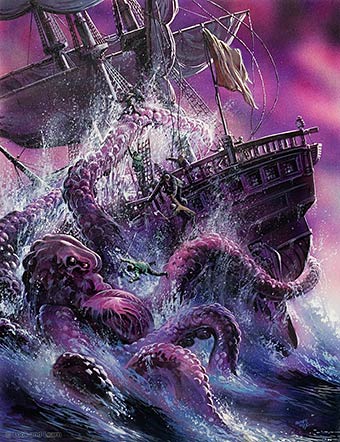Kraken
are mythical sea monsters of gargantuan size, said to have dwelt off the
coasts of Norway and Iceland. The sheer size and fearsome appearance
attributed to the beasts have made them common ocean-dwelling monsters in
various fictional works. The legend may actually have originated from
sightings of real giant squid that are variously estimated to grow to
13–15 m (40–50 ft) in length, including the tentacles. These creatures
normally live at great depths, but have been sighted at the surface and
reportedly have “attacked” ships.
Kraken
is the definite article form of krake, a Scandinavian word designating an
unhealthy animal, or something twisted. In modern German, Krake (plural and
declined singular: Kraken) means octopus, but can also refer to the
legendary Kraken.
Even though the name kraken never appears in the Norse sagas, there are similar sea monsters, the hafgufa and lyngbakr, both described in Örvar-Odds saga as a giant spider-creature. Carolus Linnaeus included kraken as cephalopods with the scientific name Microcosmus in the first edition of his Systema Naturae (1735), a taxonomic classification of living organisms, but excluded the animal in later editions. Kraken were also extensively described

by
Erik
Pontoppidan, bishop of Bergen, in his “Natural History of Norway”
(Copenhagen, 1752–3). Early accounts, including Pontoppidan’s, describe
the kraken as an animal “the size of a floating island” whose real
danger for sailors was not the creature itself, but the whirlpool it created
after quickly descending back into the ocean. However, Pontoppidan also
described the destructive potential of the giant beast: “It is said that
if it grabbed the largest warship, it could manage to pull it down to the
bottom of the ocean” (Sjögren, 1980). Kraken were always distinct from
sea serpents, also common in Scandinavian lore (Jörmungandr for instance).
According
to Pontoppidan, Norwegian fishermen often took the risk of trying to fish
over kraken, since the catch was so good. If a fisherman had an unusually
good catch, they used to say to each other, “You must have fished on
Kraken.” Pontoppidan also claimed that the monster was sometimes mistaken
for an island, and that some maps that included islands that were only
sometimes visible were actually indicating kraken. Pontoppidan also proposed
that a young specimen of the monster once died and was washed ashore at
Alstahaug (Bengt Sjögren, 1980).
Since
the late 18th century, kraken have been depicted in a number of ways,
primarily as large octopus-like creatures, and it has often been alleged
that Pontoppidan’s kraken might have been based on sailors’ observations
of the giant squid. In the earliest descriptions, however, the creatures
were more crab- like than octopus-like, and generally possessed traits that
are associated with large whales rather than with giant squid. Some traits
of kraken resemble undersea volcanic activity occurring in the Iceland
region, including bubbles of water; sudden, dangerous currents; and
appearance of new islets.
In
1802, the French malacologist Pierre Dénys de Montfort recognized the
existence of two kinds of giant octopus in Histoire Naturelle Générale et
Particuličre des Mollusques, an encyclopedic description of mollusks.
Montfort claimed that the first type, the kraken octopus, had been described
by Norwegian sailors and American whalers, as well as ancient writers such
as Pliny the Elder. The much larger second type, the colossal octopus
(depicted in the above image), was reported to have attacked a sailing
vessel from Saint-Malo, off the coast of Angola.
Montfort
later dared more sensational claims. He proposed that ten British warships
that had mysteriously disappeared one night in 1782 must have been attacked
and sunk by giant octopuses. Unfortunately for Montfort, the British knew
what had happened to the ships, resulting in a disgraceful revelation for
Montfort. Pierre Dénys de Montfort’s career never recovered and he died
starving and poor in Paris around 1820 (Sjögren, 1980). In defense of
Pierre Dénys de Montfort, it should be noted that many of his sources for
the “kraken octopus” probably described the very real giant squid,
Archeteuthis, proven to exist in 1857.
In
1830, possibly aware of Pierre Dénys de Montfort’s work, Alfred Tennyson
published his popular poem “The Kraken” (essentially an irregular
sonnet), which disseminated Kraken in English with its long-standing
superfluous the. The poem, in its last three lines, also bears similarities
to the legend of Leviathan, a sea monster, who shall rise to the surface at
the end of days.